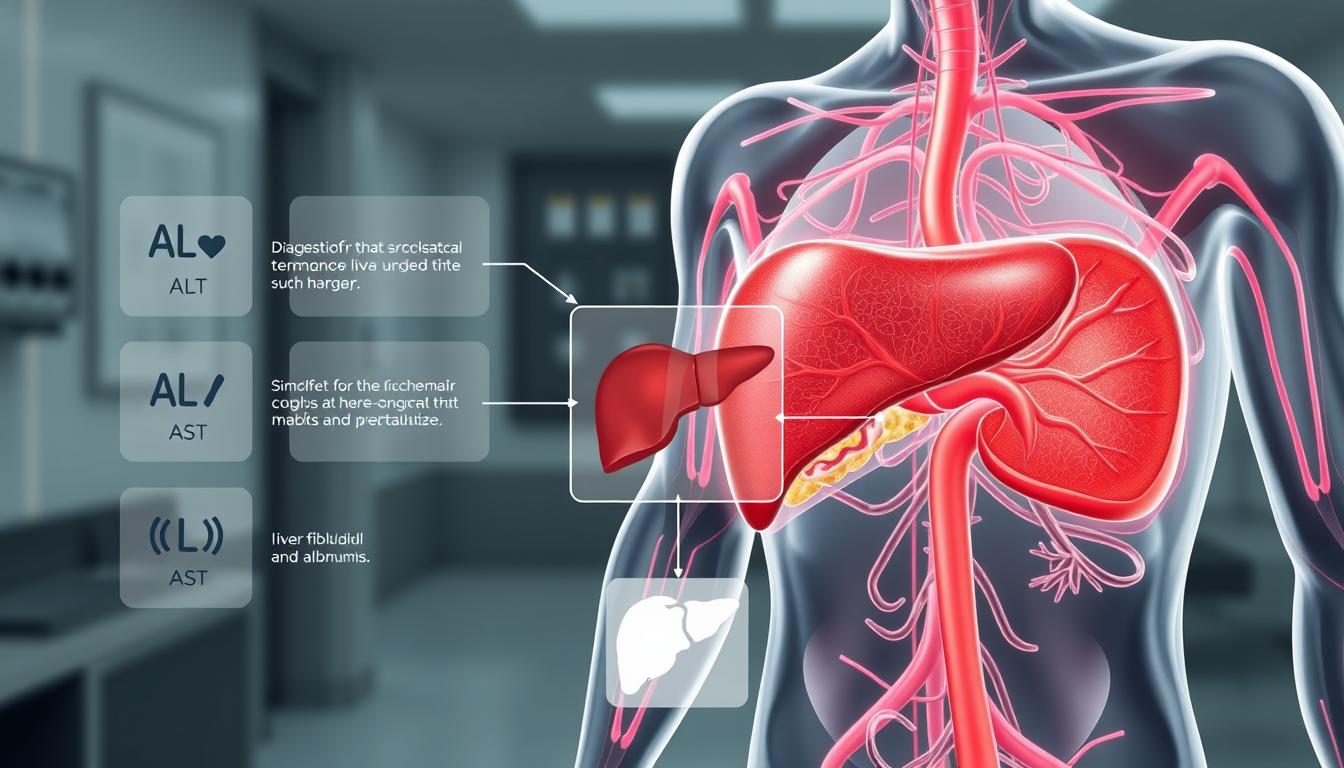Liver disease affects over 3.5 million people in the United States, with many cases going undiagnosed until the later stages. A crucial tool in diagnosing and monitoring liver health is the liver function test.
These tests measure various enzymes and proteins in the blood to assess liver damage or disease. Understanding what these tests measure and what the results mean can be daunting, but it’s essential for maintaining good health.
In this article, we’ll break down the different components of liver function tests and explain what normal results look like, helping you better understand your liver health.
Key Takeaways
- Liver function tests are crucial for diagnosing and monitoring liver disease.
- These tests measure various enzymes and proteins in the blood.
- Understanding test results is key to maintaining good liver health.
- We’ll explore what normal liver function test results look like.
- Knowledge of liver health can help prevent liver disease.
What Are Liver Function Tests?
The liver plays a vital role in the body’s metabolic processes, and liver function tests help doctors evaluate its performance and identify any abnormalities. These tests are crucial for diagnosing and monitoring liver diseases, providing insights into the liver’s condition.

Purpose of Liver Function Testing
Liver function tests are used to assess the liver’s overall health by measuring various enzymes and proteins in the blood. The primary purpose of these tests is to diagnose and monitor liver diseases such as hepatitis, cirrhosis, and fatty liver disease. By evaluating liver function, doctors can determine the extent of liver damage and develop an appropriate treatment plan.
When Doctors Order These Tests
Doctors may order liver function tests for various reasons, including symptoms of liver disease, such as jaundice, abdominal pain, or abnormal liver enzyme levels. These tests are also ordered during routine check-ups, before surgery, or when patients are taking medications that can affect the liver. The table below summarizes common scenarios when liver function tests are ordered.
| Scenario | Description |
|---|---|
| Symptoms of Liver Disease | Jaundice, abdominal pain, or other symptoms indicating potential liver issues. |
| Routine Check-ups | Part of a regular health examination to monitor overall health. |
| Pre-Surgical Tests | To assess liver health before undergoing surgery. |
| Medication Monitoring | For patients on medications known to affect liver function. |
By understanding the purpose and application of liver function tests, patients can better comprehend their liver function test results and the implications for their health. Accurate interpreting liver function tests is crucial for diagnosing and managing liver conditions effectively.
How to Prepare for a Liver Function Test
Understanding how to prepare for a liver function test can make a significant difference in the accuracy of your results. Proper preparation helps ensure that the test outcomes are reliable and informative for your healthcare provider.
Fasting Requirements
One common requirement for a liver function test is fasting. You may be asked to fast for 8-12 hours before the test to ensure that your diet does not affect the results. It’s essential to follow the instructions provided by your healthcare provider regarding fasting.
Medication Considerations
Certain medications and supplements can impact your liver function test results. Inform your doctor about any medications, vitamins, or supplements you are taking. This information will help your healthcare provider interpret your test results accurately.
| Preparation Step | Description |
|---|---|
| Fasting | Avoid eating and drinking for 8-12 hours before the test |
| Medication Disclosure | Inform your doctor about any medications or supplements you’re taking |
What to Tell Your Doctor Beforehand
Before your liver function test, inform your doctor about any health conditions, allergies, or recent illnesses. This information is crucial for accurate test results and interpretation.
Normal Liver Function Test Values Explained Simply
Understanding normal liver function test values is crucial for interpreting your test results accurately. Liver function tests (LFTs) are a group of tests used to assess the state of your liver health. These tests measure various enzymes, proteins, and other substances produced or cleared by the liver.
Overview of a Standard Liver Panel
A standard liver panel typically includes tests for alanine transaminase (ALT), aspartate transaminase (AST), alkaline phosphatase (ALP), total bilirubin, direct bilirubin, and albumin. These tests help doctors evaluate liver damage, disease, or dysfunction.
| Test | Normal Range | Significance |
|---|---|---|
| ALT | 0-40 U/L | Measures liver cell damage |
| AST | 0-40 U/L | Measures liver cell damage and other tissue damage |
| ALP | 30-120 U/L | Measures bile duct obstruction or bone disease |
What Constitutes “Normal” Values
Normal values for liver function tests can vary slightly between laboratories but generally fall within established reference ranges. These ranges are determined by testing large populations of healthy individuals.
Understanding Reference Ranges
Reference ranges for liver function tests are not universal and can be influenced by factors such as age, sex, and laboratory standards. Understanding these ranges is essential for accurate interpretation of test results.
It’s also important to note that “normal” does not always mean “healthy.” Some liver conditions may not be reflected in abnormal test results. Therefore, interpreting liver function test results requires a comprehensive understanding of the individual’s overall health and medical history.
Interpreting Liver Enzyme Results
Analyzing liver enzyme levels is an essential step in evaluating liver function and detecting potential problems. Liver enzymes, particularly Alanine Transaminase (ALT) and Aspartate Transaminase (AST), are critical markers of liver health.
Normal ALT Levels and What They Mean
ALT is primarily found in the liver, and elevated levels often indicate liver damage. Normal ALT levels typically range from 0 to 40 units per liter. Levels within this range usually suggest that the liver is functioning properly. However, it’s essential to consider these results in the context of overall health and other liver function tests.
Normal AST Levels and Their Significance
AST is found in various tissues, including the liver, heart, and muscles. Normal AST levels are generally between 0 to 40 units per liter. While AST is not as specific to the liver as ALT, elevated AST levels can indicate liver damage among other conditions.
The AST/ALT Ratio Explained
The ratio of AST to ALT can provide additional insights into the cause of liver damage. A ratio greater than 2:1 often suggests alcoholic liver disease, whereas a ratio less than 1 is more commonly associated with non-alcoholic fatty liver disease. Understanding this ratio helps in diagnosing the underlying cause of abnormal liver enzyme levels.
Understanding Bilirubin and Protein Measurements
Bilirubin and protein measurements are key components of liver function tests, helping diagnose and monitor liver diseases. These measurements provide critical information about the liver’s ability to process bilirubin and produce essential proteins.
Total, Direct, and Indirect Bilirubin
Bilirubin is a yellow pigment produced during the breakdown of hemoglobin in the liver. It exists in two main forms: direct (conjugated) and indirect (unconjugated). Total bilirubin is the sum of both direct and indirect bilirubin. Elevated levels of indirect bilirubin can indicate issues such as hemolysis, while high direct bilirubin levels may suggest liver dysfunction or bile duct obstruction.
Normal bilirubin levels typically range from 0.1 to 1.2 mg/dL for total bilirubin. Understanding the balance between direct and indirect bilirubin is crucial for diagnosing the cause of elevated bilirubin levels.
Albumin and Total Protein Values
Albumin and total protein measurements are also vital components of liver function tests. Albumin is a protein made by the liver, and its levels can indicate the liver’s synthetic capacity. Low albumin levels may suggest chronic liver disease or cirrhosis. Total protein includes albumin and other proteins, such as globulins. Abnormal total protein levels can indicate various health issues, including liver disease.
What These Values Indicate About Liver Health
The measurements of bilirubin, albumin, and total protein provide a comprehensive view of liver health. Abnormalities in these values can indicate liver dysfunction, disease, or other related conditions. For instance, elevated bilirubin levels alongside low albumin levels may suggest significant liver impairment.
Understanding these measurements and their implications is essential for both healthcare providers and patients to manage liver health effectively.
How to Read Additional Liver Function Markers
Beyond the basics, additional liver markers offer a clearer picture of liver health. These include Alkaline Phosphatase (ALP), Gamma-Glutamyl Transferase (GGT), and Prothrombin Time (PT), each providing unique insights into liver function and potential disorders.
Alkaline Phosphatase (ALP)
ALP is an enzyme found in the liver, bones, and other tissues. Elevated ALP levels can indicate bone disorders or liver diseases such as cholestasis, where bile flow is reduced or blocked. It’s essential to consider ALP levels in the context of other liver tests and overall health.
Gamma-Glutamyl Transferase (GGT)
GGT is another enzyme that can be measured to assess liver health. High GGT levels, especially when combined with elevated ALP, can confirm that liver disease is the cause of abnormal ALP levels. GGT is also sensitive to alcohol consumption, making it a useful marker for detecting alcohol-related liver damage.
Prothrombin Time (PT)
PT measures how long it takes blood to clot, a process that involves proteins produced by the liver. Prolonged PT can indicate severe liver dysfunction, as the liver is not producing enough clotting factors. This test is critical in assessing the liver’s synthetic function.
Understanding these additional markers is crucial for a comprehensive assessment of liver health. By interpreting ALP, GGT, and PT alongside other liver function tests, healthcare providers can gain a more detailed understanding of a patient’s condition and develop appropriate treatment plans.
What Affects Your Liver Test Results
Understanding the factors that influence liver function test results is essential for accurate interpretation. Various elements can impact your liver test outcomes, and being aware of these can help you prepare.
Medications and Supplements
Certain medications and supplements can significantly affect liver enzyme levels. For instance, statins used to lower cholesterol can elevate liver enzymes. It’s crucial to inform your doctor about any medications or supplements you’re taking.
Diet and Alcohol Consumption
Dietary habits and alcohol consumption play a substantial role in liver health. Consuming high amounts of alcohol can lead to elevated liver enzymes, while a diet high in processed foods can also impact liver function.
Exercise and Physical Activity
Exercise can influence liver test results, particularly if it’s intense or occurs close to the time of testing.
Timing of Exercise Before Testing
It’s generally recommended to avoid strenuous exercise 24-48 hours before a liver function test to prevent temporary elevations in liver enzymes.
Impact of Intense Workouts
Intense workouts can cause temporary changes in liver enzyme levels. Understanding this can help in interpreting test results more accurately.
| Factor | Impact on Liver Test Results |
|---|---|
| Medications and Supplements | Can elevate liver enzymes |
| Diet and Alcohol Consumption | Can impact liver function and enzyme levels |
| Exercise and Physical Activity | Can cause temporary changes in liver enzymes |
Conclusion: Maintaining Healthy Liver Function
Understanding liver function tests explained in simple terms empowers individuals to take control of their liver health. Normal liver function test values explained simply can help identify potential issues before they become severe.
Maintaining healthy liver function is crucial for overall well-being. A healthy lifestyle, including a balanced diet and regular exercise, can significantly contribute to liver health. It’s also essential to be aware of the factors that can affect liver test results, such as certain medications and alcohol consumption.
By being informed and proactive, individuals can work with their healthcare providers to monitor and manage their liver health effectively. Regular check-ups and a commitment to a healthy lifestyle can go a long way in ensuring optimal liver function.
